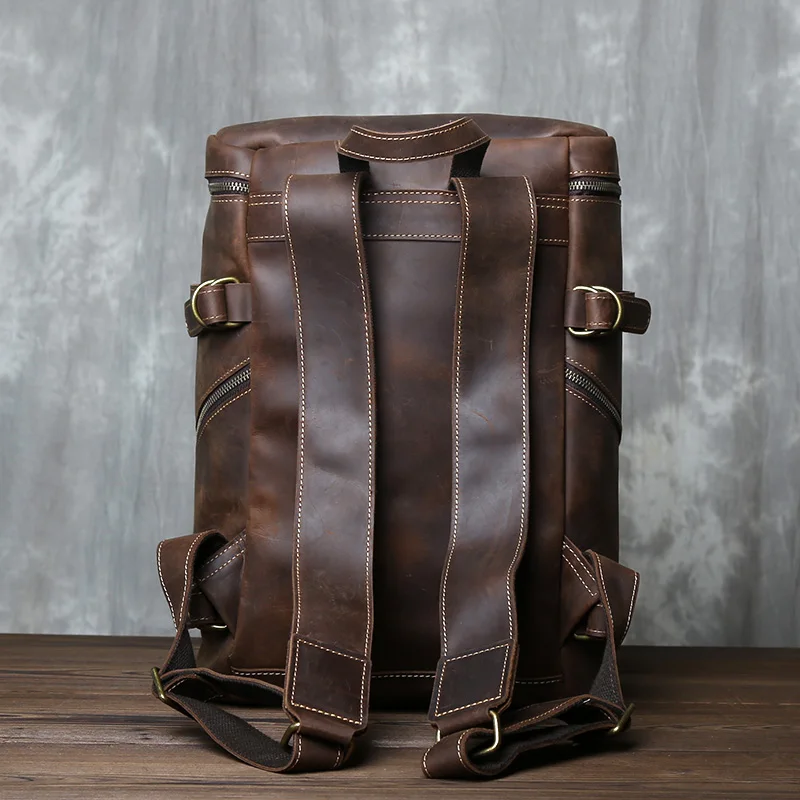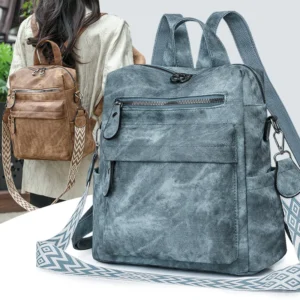Introduction to Eco-Friendly Leather Sourcing
In today’s marketplace, eco-friendly leather sourcing has evolved far beyond simple “green” marketing buzzwords into a comprehensive approach that transforms how premium leather goods are produced. This sustainable approach encompasses everything from how animal hides are sourced to the final stages of product creation and eventual recycling.
The leather industry is experiencing a significant shift as consumers increasingly demand products that align with their environmental values. Research shows searches for “sustainable leather” have increased by over 60% in recent years, signaling a growing awareness about how leather products impact our planet.
For premium leather goods, this shift represents both a challenge and an opportunity. Sustainability in leather isn’t just about reducing environmental harm—it’s fundamentally connected to quality, durability, and character. The most environmentally responsible leather products are often those crafted to last for decades, developing rich patina and personality with use.
Key aspects of truly eco-friendly leather sourcing include:
- Responsible raw material procurement that prioritizes animal welfare
- Innovative tanning processes that reduce chemical use and pollution
- Resource efficiency throughout the production process
- Transparent supply chains that allow for accountability
- Emphasis on product longevity and repair
The foundation of sustainable leather lies in understanding that true quality and environmental responsibility go hand-in-hand. Full-grain leather backpacks that maintain their integrity for many years represent sustainability in its most practical form—reducing the need for frequent replacements and keeping materials out of landfills.
This guide will take you through what makes leather sourcing truly sustainable, helping you distinguish between genuine environmental responsibility and empty marketing claims.
The Environmental Impact of Traditional Leather Production
Understanding what makes eco-friendly leather important starts with recognizing the environmental challenges associated with conventional leather production. Traditional leather manufacturing creates several significant environmental concerns that sustainable practices aim to address.
Resource-Intensive Livestock Raising
While most quality leather comes as a by-product of the meat and dairy industries (rather than from animals raised specifically for their hides), the environmental footprint of livestock remains substantial:
- High water consumption: Cattle require thousands of gallons of water throughout their lifespan
- Land use: Grazing land sometimes contributes to deforestation
- Methane emissions: Livestock produce greenhouse gases that contribute to climate change
Chemical-Heavy Processing
The transformation from raw hide to usable leather traditionally involves numerous chemicals that pose environmental risks:
- Chrome tanning, the most common method worldwide, uses chromium salts that can contaminate water systems if improperly managed
- While chromium III (used in tanning) is relatively safe, it can convert to toxic chromium VI under certain conditions
- A single traditionally tanned hide can involve up to 250-300 pounds of chemicals
Water Consumption and Pollution
Conventional leather processing is exceptionally water-intensive:
* Traditional tanning methods may use 16-22 gallons of water per pound of processed hide
* Wastewater often contains high concentrations of salt, acids, chromium, and other chemicals
* In areas with concentrated tannery operations, water pollution has created serious environmental and health concerns
Waste Management Challenges
The leather industry generates significant solid waste:
* Up to 70% of the original hide weight becomes waste during processing
* Untreated waste can release hydrogen sulfide and ammonia when decomposing
* Many conventional operations lack proper waste treatment facilities
Labor and Ethical Concerns
Environmental impacts often intersect with human welfare issues:
* Workers in conventional tanneries may face exposure to harmful chemicals
* Poor waste management affects surrounding communities through water and soil contamination
Understanding these environmental challenges provides important context for the proper leather maintenance guide for commuters, as proper care extends product life and reduces the need for replacement, thereby lessening overall environmental impact.
Core Principles of Sustainable Leather Sourcing
Moving beyond the problems of conventional leather production, truly sustainable leather sourcing follows several essential principles that guide responsible practices from farm to finished product.
1. Lifecycle Approach
Sustainable leather considers environmental impact at every stage:
* Raw material sourcing that minimizes harm
* Processing methods that reduce chemical use
* Manufacturing practices that conserve resources
* Product design focused on longevity and repair
* End-of-life considerations for eventual recycling or biodegradation
2. By-Product Utilization
Responsible leather sourcing views hides as valuable resources to be utilized rather than wasted:
* Prioritizing leather from the meat and dairy industries ensures no animals are raised solely for their hides
* This approach transforms what could be waste into durable goods
* Using meat industry by-products means the environmental footprint is shared across multiple products
3. Traceability and Transparency
Sustainable leather production maintains visibility throughout the supply chain:
* Ability to trace hides back to their source
* Documentation of all processing chemicals and methods
* Clear communication about production practices to consumers
* Third-party verification of environmental claims
4. Balancing Environmental Impact with Longevity
The most sustainable leather products are those that last:
* High-quality materials that resist wear and aging
* Construction techniques that allow for repair
* Timeless design that resists fashion obsolescence
* The environmental cost of production is offset by years of use
This principle is particularly evident in vintage leather backpacks that continue to perform well after many years of use, often becoming more attractive as they develop patina and character.
5. Resource Efficiency
Sustainable leather operations minimize waste at every stage:
* Water recycling and conservation in processing
* Energy efficiency throughout production
* Chemical recovery and reuse systems
* Waste material repurposing into smaller leather goods
6. Animal Welfare Considerations
Ethical treatment of animals is a cornerstone of truly sustainable leather:
* Sourcing from farms with humane animal husbandry practices
* Respect for animal welfare during transportation
* Support for farming systems that allow natural behaviors
These core principles work together to create leather goods that not only minimize environmental harm but often result in superior products with better aging characteristics and longer useful lives.

Responsible Raw Material Sourcing
The journey toward sustainable leather begins with how the raw materials—animal hides—are sourced. Responsible sourcing establishes the foundation for all subsequent sustainability efforts.
By-Product Sourcing
Premium sustainable leather begins as a by-product of the food industry:
* Utilizing hides that would otherwise be discarded ensures nothing goes to waste
* This approach prevents the environmental impact of raising animals solely for their skins
* It creates value from what would otherwise be a waste stream
* Studies show that using leather as a by-product reduces the overall carbon footprint by distributing the environmental impact across multiple products
Certifications for Responsible Husbandry
Several certification systems help verify the ethical treatment of animals:
* Animal Welfare Approved certification ensures humane animal raising practices
* Regenerative Organic Certified indicates farms that go beyond sustainability to actually improve soil health
* Global Organic Textile Standard (GOTS) includes animal welfare criteria
Addressing Deforestation Concerns
Responsible leather sourcing must consider the landscape impact of cattle raising:
* Leather traceability programs like the Leather Working Group’s traceability module help verify hides don’t come from deforested areas
* Zero-deforestation commitments from major leather producers help protect vital ecosystems
* Satellite monitoring increasingly verifies land use claims
Regional Sourcing Benefits
Obtaining hides from nearby sources offers several sustainability advantages:
* Reduced transportation emissions
* Better oversight of farming practices
* Support for local agricultural communities
* Enhanced traceability and quality control
The connection between responsible sourcing and product performance becomes evident when discussing the ultimate guide to conditioning leather backpacks, as properly sourced leather responds better to conditioning treatments, extending product lifespan and maintaining appearance.
Traceability Systems
Verifying sourcing claims requires robust tracking systems:
* Blockchain technology increasingly provides unalterable records of a hide’s journey
* DNA testing can verify animal species and sometimes region of origin
* Physical tagging systems follow hides through the supply chain
* Digital passports document each step from farm to finished product
By ensuring responsible raw material sourcing, manufacturers lay the groundwork for truly sustainable leather goods that perform well while minimizing environmental impact.
Sustainable Tanning Methods and Processes
The tanning process—transforming raw hides into stable, usable leather—represents one of the most environmentally significant stages in leather production. Sustainable approaches focus on reducing the chemical, water, and energy footprints of this crucial step.
Vegetable Tanning: Traditional Sustainability
One of the oldest tanning methods remains among the most environmentally friendly:
* Uses tannins extracted from bark, leaves, and plant parts instead of metals or synthetic chemicals
* Produces leather that develops rich patina over time
* Creates biodegradable leather products
* Results in distinctive texture and appearance
Chrome-Free Alternatives
Modern sustainable tanneries have developed alternatives to standard chrome tanning:
* Aldehyde tanning uses organic compounds for leather stabilization
* Synthetic tanning agents mimic natural tannins with controlled chemistry
* Wet-white tanning provides chrome-free leather suitable for various applications
Improved Chrome Tanning
When chrome tanning is used, sustainable operations implement safeguards:
* Closed-loop systems capture and reuse chromium compounds
* Precise chemical dosing reduces excess use
* Proper wastewater treatment prevents environmental contamination
* Modern techniques achieve similar results with significantly less chromium
Water and Energy Conservation
Sustainable tanneries implement various conservation techniques:
* Float shortening reduces water usage during processing
* Advanced drum designs minimize water requirements
* Heat recovery systems capture energy from warm wastewater
* Solar thermal systems provide process heat with renewable energy
| Tanning Method | Environmental Benefits | Performance Characteristics | Typical Applications |
|---|---|---|---|
| Vegetable Tanning | Biodegradable, low toxicity, renewable resources | Firm structure, develops patina, natural appearance | Leather backpacks, belts, heavy-duty items |
| Improved Chrome | Less chemical use, closed-loop systems | Soft, flexible, consistent results | Versatile use, many colors possible |
| Aldehyde | Metal-free, reduced toxicity | Soft, washable in some cases | Specialized applications |
| Synthetic | Controlled chemistry, reduced toxicity | Consistent results, versatile | Various products with specific requirements |
The tanning method directly impacts how leather will perform and age over time, which is why understanding DIY leather care for travel backpacks becomes essential—different tanning methods require different care approaches to maintain optimal performance and appearance.
Chemical Management
Responsible tanneries carefully manage the chemicals used in processing:
* ZDHC (Zero Discharge of Hazardous Chemicals) protocols eliminate the most harmful substances
* Chemical inventories track all substances entering and leaving the facility
* Substitution of hazardous substances with safer alternatives
* Worker training in safe chemical handling practices
The tanning process fundamentally determines leather’s characteristics, performance, and environmental impact throughout its entire lifecycle.

Resource Efficiency and Waste Management in Leather Production
Beyond tanning, sustainable leather production encompasses comprehensive resource efficiency and waste management strategies that minimize environmental impact throughout manufacturing.
Water Conservation and Recycling
Advanced sustainable tanneries implement sophisticated water management:
* Counterflow rinsing techniques reuse water multiple times
* Membrane filtration systems clean process water for reuse
* Rainwater harvesting reduces freshwater consumption
* Biological treatment creates water clean enough for discharge or reuse
* Modern facilities achieve up to 40-60% water reduction compared to conventional operations
Energy Efficiency Innovations
Sustainable leather production prioritizes reducing energy consumption:
* Variable speed motors adjust to actual production needs
* Thermal insulation reduces heat loss during processing
* Low-temperature processing techniques reduce energy requirements
* Natural lighting and LED systems minimize electricity for illumination
* Solar thermal installations provide hot water for processing
Chemical Recovery Systems
Circular approaches to chemical use reduce both costs and environmental impact:
* Salt recovery from pickling processes
* Chrome recovery and reuse from tanning liquors
* Lime recycling from deliming operations
* Sulfide oxidation for safer wastewater treatment
Solid Waste Management
Innovative approaches transform potential waste into valuable resources:
* Collagen extraction from trimmings for food and cosmetic industries
* Conversion of protein waste into fertilizers
* Leather fiber composites from ground scraps
* Biogas generation from organic waste components
Understanding how sustainable production extends product life reinforces the importance of complete guide to waterproofing leather bags, as proper waterproofing prevents damage that would shorten a product’s useful life.
Circular Economy Applications
Leading sustainable leather producers embrace circular principles:
* Design for disassembly allows component recycling at end of life
* Repair services extend product lifespans
* Upcycling transforms waste cuts into smaller goods
* Take-back programs ensure responsible end-of-life handling
By implementing comprehensive resource efficiency and waste management, sustainable leather producers significantly reduce their environmental footprint while often improving product quality and consistency.
Understanding Leather Working Group (LWG) Certification
The Leather Working Group (LWG) has established the most widely recognized environmental certification specifically for leather manufacturers, providing a robust framework for assessing tannery sustainability performance.
What is the Leather Working Group?
Founded in 2005, the LWG represents a multi-stakeholder collaboration:
* Brings together brands, retailers, product manufacturers, and tanneries
* Develops protocols for environmental compliance and best practices
* Conducts independent audits of leather production facilities
* Awards ratings based on comprehensive environmental performance assessment
The Certification Process
LWG certification involves rigorous evaluation:
* Independent, trained auditors conduct on-site facility assessments
* Documentation review verifies policies and procedures
* Physical inspection confirms equipment and practices
* Performance data analysis evaluates resource efficiency
* Re-certification required every two years to maintain status
LWG Rating Levels
Tanneries receive ratings based on their overall performance:
* Gold (85-100 points): Exemplary environmental performance
* Silver (75-84 points): Strong environmental systems exceeding compliance
* Bronze (65-74 points): Good environmental practices meeting requirements
* Audited (50-64 points): Basic compliance with environmental standards
* Fail (below 50 points): Does not meet minimum requirements
What LWG Evaluates
The audit examines multiple aspects of leather production:
* Environmental management systems
* Energy consumption
* Water usage and effluent treatment
* Air emissions control
* Waste management practices
* Chemical management and restricted substances
* Traceability of raw materials
* Health and safety practices
Many luxury leather backpack manufacturers specifically seek LWG-certified tanneries to ensure their premium products meet environmental standards that match their quality positioning.
Limitations of LWG Certification
While comprehensive, LWG certification has boundaries:
* Focuses primarily on manufacturing rather than raw material production
* Does not directly assess animal welfare practices
* Represents environmental performance but not all sustainability aspects
* Limited to the tannery phase, not the entire supply chain
Understanding LWG certification provides consumers and manufacturers with a valuable tool for assessing the environmental credentials of leather suppliers and products.
Additional Certifications and Standards for Ethical Leather
While the Leather Working Group provides comprehensive environmental assessment specifically for tanneries, several other certifications address different aspects of sustainable and ethical leather production.
Material-Specific Standards
- OEKO-TEX Leather Standard: Tests finished leather for harmful substances, ensuring products are safe for human use and contact
- CSCB (Brazilian Leather Certification of Sustainability): Evaluates environmental, social, and economic aspects of tanneries in Brazil
- ICEC (Institute of Quality Certification for the Leather Sector): Italian certification covering environmental performance, social accountability, and product quality
Environmental Management Systems
- ISO 14001: International standard for environmental management systems that helps organizations minimize negative impacts
- EMAS (Eco-Management and Audit Scheme): European Union’s voluntary environmental management instrument
Chemical Safety Regulations
- REACH (Registration, Evaluation, Authorization and Restriction of Chemicals): European Union regulation addressing chemical production and use
- MRSL (Manufacturing Restricted Substances List): Identifies chemicals not to be intentionally used in leather production
- ZDHC (Zero Discharge of Hazardous Chemicals): Initiative to eliminate hazardous chemicals from the leather and textile supply chains
Animal Welfare Certifications
- Responsible Leather Round Table: Develops standards for responsible leather production including animal welfare
- Leather Naturally: Promotes sustainable and responsible leather throughout the value chain
- Animal Welfare Approved: Certifies humane treatment in animal husbandry
Many products featuring essential waterproof leather backpack features rely on these certifications to verify that materials not only perform well but are also produced responsibly.
Complementary Certification Systems
No single certification covers all aspects of sustainable leather, so complementary systems work together:
* LWG might verify tannery environmental performance
* OEKO-TEX confirms the finished leather is free from harmful substances
* Social accountability certifications address worker conditions
* Animal welfare certifications verify ethical sourcing
Understanding these various certifications helps manufacturers create truly comprehensive sustainability programs and assists consumers in making informed choices about leather products.
Vegetable-Tanned Leather: Benefits and Considerations
Among sustainable leather options, vegetable-tanned leather stands out for its traditional production method and distinctive characteristics. This ancient tanning process offers significant environmental benefits while creating leather with unique aesthetic and performance properties.
The Vegetable Tanning Process
This traditional method uses natural tannins extracted from plant sources:
* Common sources include oak bark, chestnut wood, mimosa bark, and quebracho wood
* Tannins slowly penetrate and stabilize the collagen fibers in the hide
* Process typically takes weeks rather than days (compared to chrome tanning)
* Requires skilled artisanal knowledge and careful monitoring
Environmental Advantages
Vegetable tanning offers several ecological benefits:
* Uses renewable, biodegradable materials rather than metals
* Produces biodegradable leather that will eventually return to nature
* Eliminates chromium from the tanning process
* Often uses less hazardous chemicals overall
* Creates minimal pollution when properly managed
Unique Aesthetic Properties
Vegetable-tanned leather possesses distinctive visual and tactile qualities:
* Natural color ranges from light tan to rich brown
* Develops a beautiful patina over time that tells the story of use
* Ages gracefully, often becoming more attractive with wear
* Has a firm, substantial feel that communicates quality
* Takes tooling and embossing exceptionally well
Understanding whether leather should dry before conditioning is particularly important with vegetable-tanned leather, as proper timing of conditioning treatments helps preserve its distinctive qualities and extend its lifespan.
Durability and Aging Characteristics
The performance of vegetable-tanned leather changes over its lifetime:
* Initially firmer than chrome-tanned alternatives
* Develops suppleness through use and proper conditioning
* Forms to the user’s patterns with continued use
* Generally more resistant to heat than chrome-tanned leather
* May show water spots more readily but can be restored
Limitations and Best Applications
Vegetable tanning isn’t ideal for every application:
* Limited color palette compared to chrome-tanned leather
* More susceptible to water staining initially
* Generally heavier and less supple in early use
* Higher production cost due to longer tanning time
* Requires more specific care to maintain optimal appearance
Vegetable-tanned leather represents a traditional approach to sustainability that creates products with character, longevity, and a connection to historical craftsmanship.
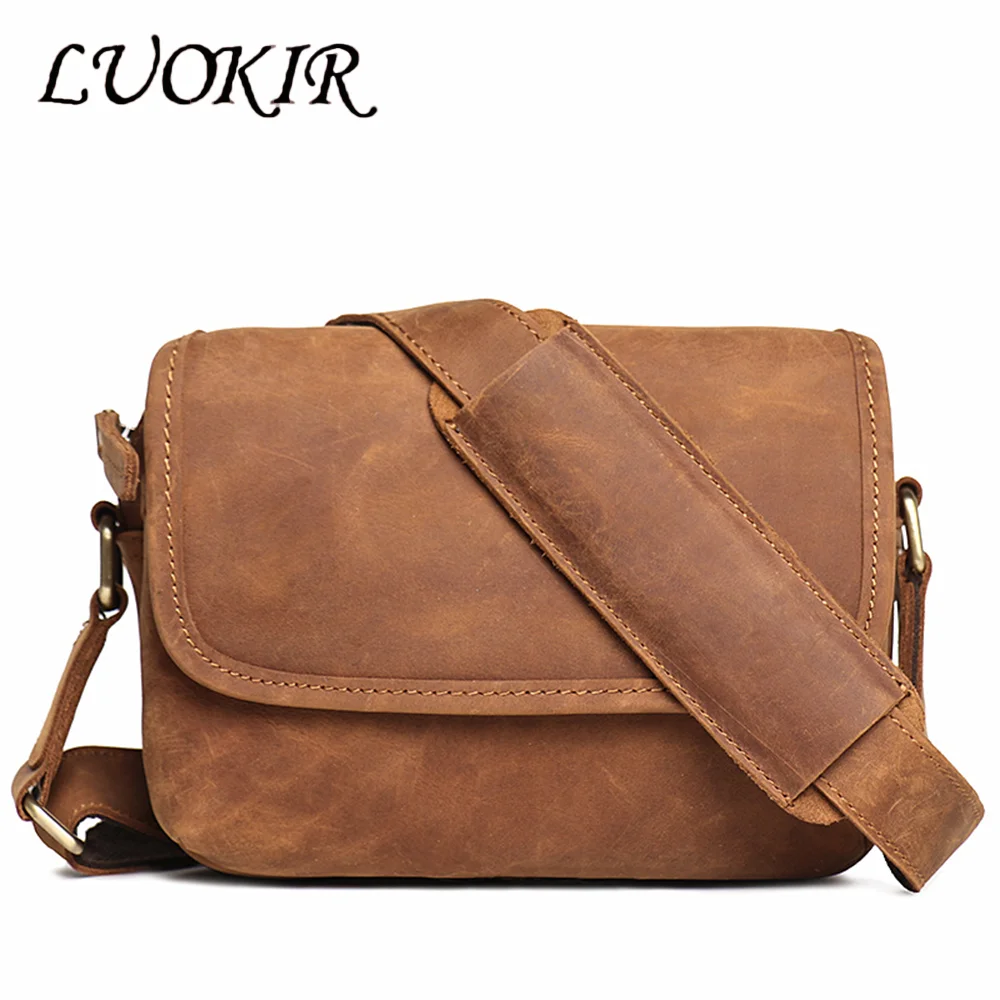
Modern Innovations in Sustainable Leather Processing
While traditional methods like vegetable tanning offer environmental benefits, cutting-edge technology is also driving significant sustainability improvements throughout leather production. These innovations enable better resource efficiency while maintaining or enhancing leather quality.
Advanced Chrome-Free and Low-Impact Tanning
Modern chemistry has developed more sustainable tanning alternatives:
* Metal-free tanning systems using synthetic organic compounds
* X-Tan technology that reduces chemical usage by up to 90%
* White tanning methods that enable bright colors without chrome
* Enzyme-assisted processes that reduce chemical requirements
* Low-temperature tanning that saves energy
Water Reduction Technologies
Innovative equipment and processes dramatically decrease water consumption:
* Ultrafiltration systems that clean and recycle process water
* Dry tanning technologies that use minimal water
* Microprocessor-controlled automated dosing systems
* Closed-loop water circuits that continuously filter and reuse water
* High-exhaustion processes that leave fewer chemicals in wastewater
Many men’s leather backpacks now benefit from these improved production methods, resulting in more consistent quality with reduced environmental impact.
Energy Conservation Breakthroughs
Modern sustainable tanneries implement various energy-saving technologies:
* Heat pump systems that recover energy from wastewater
* Variable frequency drives that optimize motor efficiency
* Solar thermal installations for process water heating
* Biogas generation from organic waste to power operations
* Process optimization algorithms that minimize energy requirements
Digital and Precision Technologies
Advanced technology improves efficiency throughout production:
* Computer-controlled cutting systems that maximize hide usage
* Digital scanning that identifies optimal cutting patterns
* Precision chemical dosing that eliminates excess usage
* Real-time monitoring systems for process optimization
* Automated quality control that reduces waste
Understanding how these innovative processes affect leather performance relates to questions like does oiling leather waterproof it, as modern leathers may respond differently to treatments based on their processing methods.
Traceability Innovations
New technologies verify sustainability claims:
* Blockchain systems create unalterable records of leather’s journey
* DNA testing confirms species and sometimes regional origin
* QR codes link products to their complete production history
* RFID tracking follows materials through manufacturing
* Digital product passports document environmental attributes
These innovations demonstrate how the leather industry combines traditional craftsmanship with modern technology to create more sustainable products without sacrificing quality or performance.
The Truth About “Vegan Leather” vs. Sustainable Genuine Leather
The term “vegan leather” has gained popularity as consumers seek alternatives to animal products. However, the environmental reality is more complex than many marketing claims suggest. Understanding the true sustainability profile of different materials requires examining their full lifecycle impact.
What Is “Vegan Leather”?
Most products marketed as “vegan leather” fall into two categories:
* PVC (polyvinyl chloride)-based synthetics
* PU (polyurethane)-based synthetics
* Newer bio-based alternatives (discussed in the next section)
Environmental Impact Comparison
When assessing genuine leather against synthetic alternatives, several factors matter:
| Factor | Sustainable Genuine Leather | Typical Synthetic “Vegan Leather” |
|---|---|---|
| Raw Material Source | By-product of food industry | Petroleum (fossil fuels) |
| Production Impact | Water/chemical intensive but improving through better practices | Chemical-intensive, fossil fuel dependent |
| Durability | Typically lasts decades with proper care | Usually 2-5 years before degradation |
| Repair Potential | Can be repaired multiple times | Limited or no repair options |
| Biodegradability | Biodegrades eventually (faster with vegetable tanning) | May never fully biodegrade, creates microplastics |
| End of Life | Can be recycled, upcycled, or will biodegrade | Usually landfilled, releases microplastics |
Durability and Replacement Frequency
One of the most overlooked sustainability factors is product lifespan:
* Quality leather goods often last decades with proper leather bag treatment for outdoor use
* Most synthetic alternatives begin deteriorating within 2-5 years
* Cracking, peeling, and surface degradation requires replacement
* The environmental impact of creating three or four synthetic items may exceed one long-lasting leather item
Fossil Fuel Origin
Standard “vegan leathers” derive from non-renewable resources:
* PVC and PU require petroleum extraction
* Manufacturing process is energy-intensive
* Create plastic pollution throughout their lifecycle
* Often contain plasticizers and stabilizers with their own environmental concerns
Understanding the differences between full-grain vs top-grain leather helps consumers appreciate why certain leather types offer superior longevity, which directly impacts environmental footprint.
Balanced Assessment
Both materials have advantages and disadvantages:
* Genuine leather’s sustainability depends on responsible sourcing and production
* Synthetic alternatives avoid animal use but create different environmental challenges
* The most sustainable choice varies based on individual values and product requirements
* Innovations in both categories are improving environmental performance
This balanced perspective helps consumers make informed choices based on both their ethical values and environmental concerns.
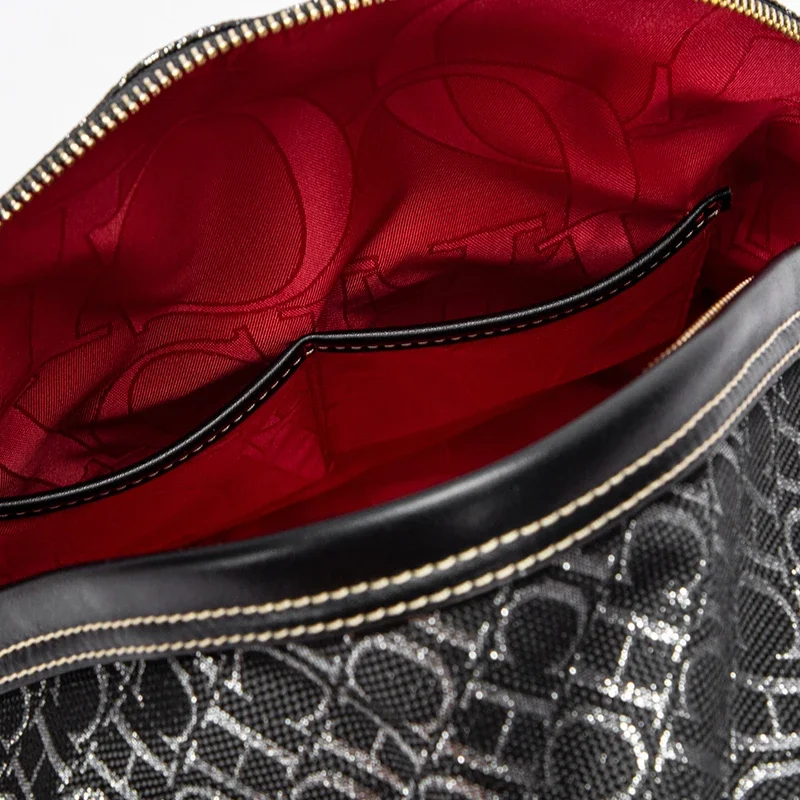
Emerging Plant-Based and Alternative Leather Materials
Beyond conventional leather and petroleum-based synthetics, innovative companies are developing new materials that aim to combine sustainability with performance. These plant-based alternatives represent exciting developments in sustainable material science.
Pineapple Leaf Leather (Piñatex)
Developed from agricultural waste from pineapple harvesting:
* Uses fibers from pineapple leaves that would otherwise be discarded
* Creates additional income for farming communities
* Requires significantly less water than animal leather production
* Creates material with leather-like appearance and moderate durability
* Still uses some synthetic resins in processing
Mushroom Leather (Mycelium-Based)
Grown from fungal networks under controlled conditions:
* Cultivated rather than harvested or manufactured
* Produces minimal waste and uses limited resources
* Can be grown to specific shapes, reducing cutting waste
* Biodegradable at end of life
* Currently limited in durability compared to animal leather
* Still scaling up for commercial production
Cactus Leather
Derived from nopal cactus plants in Mexico:
* Requires minimal water and grows on marginal land
* Harvests leaves without killing the plant
* Partially biodegradable depending on processing methods
* Offers good resistance to water and abrasion
* Requires some synthetic components for durability
Apple Skin Leather
Created from apple industry waste:
* Utilizes apple pomace (pulp) from juice production
* Diverts agricultural waste from disposal
* Combines natural and synthetic materials
* Offers variety of textures and finishes
* Currently limited application in premium products
These innovative materials may require different waterproofing approaches than traditional leather, making resources about leather waterproofing products valuable for consumers exploring alternative materials.
Current Limitations
While promising, these alternatives face challenges:
* Often still require some petroleum-based components for binding and durability
* May not match the longevity of high-quality leather
* Limited availability and higher production costs
* Processing methods continue to evolve and improve
* Performance in extreme conditions still being tested
These emerging materials represent important innovations that may eventually provide more environmentally friendly alternatives to both conventional leather and plastic-based synthetics, especially as technology continues to improve.
How to Identify and Select Truly Sustainable Leather Products
With various sustainability claims in the marketplace, consumers need practical guidance to identify genuinely eco-friendly leather products. The following steps can help guide responsible purchasing decisions.
Look for Meaningful Certifications
Start by identifying products with legitimate environmental credentials:
* Leather Working Group (LWG) certification indicates environmentally responsible tanning
* OEKO-TEX Leather Standard verifies the absence of harmful substances
* Other relevant certifications from the earlier section provide additional assurance
* Be wary of vague “eco-friendly” claims without specific certifications
Assess Transparency and Traceability
Truly sustainable brands openly share information about their supply chains:
* Clear details about where and how their leather is sourced
* Information about tanning methods and chemicals used
* Transparency about manufacturing locations and practices
* Willingness to answer specific questions about production
Evaluate Physical Quality Indicators
High-quality sustainable leather displays certain characteristics:
* Even coloration throughout (unless intentionally varied)
* Rich, natural leather scent without chemical overtones
* Supple feel that responds to touch
* Edge finishing that prevents delamination
* Visible natural grain patterns (in full-grain leather)
Many women’s leather backpacks demonstrate these quality indicators, which correlate strongly with both sustainability and long-term durability.
Consider Longevity and Repair
The most sustainable leather goods are designed for extended use:
* Sturdy construction with reinforced stress points
* Stitching that can be repaired if damaged
* Classic designs that won’t quickly become outdated
* Availability of repair services or warranty programs
* Materials that improve with age rather than deteriorate
Ask the Right Questions
When researching sustainable leather products, inquire about:
* Whether the leather comes from food industry by-products
* What tanning methods are used
* If the brand has a formal sustainability policy
* Whether they offer repair services or end-of-life take-back
* How they address waste reduction in manufacturing
By applying these evaluation criteria, consumers can identify leather products that genuinely minimize environmental impact while providing excellent quality and longevity.
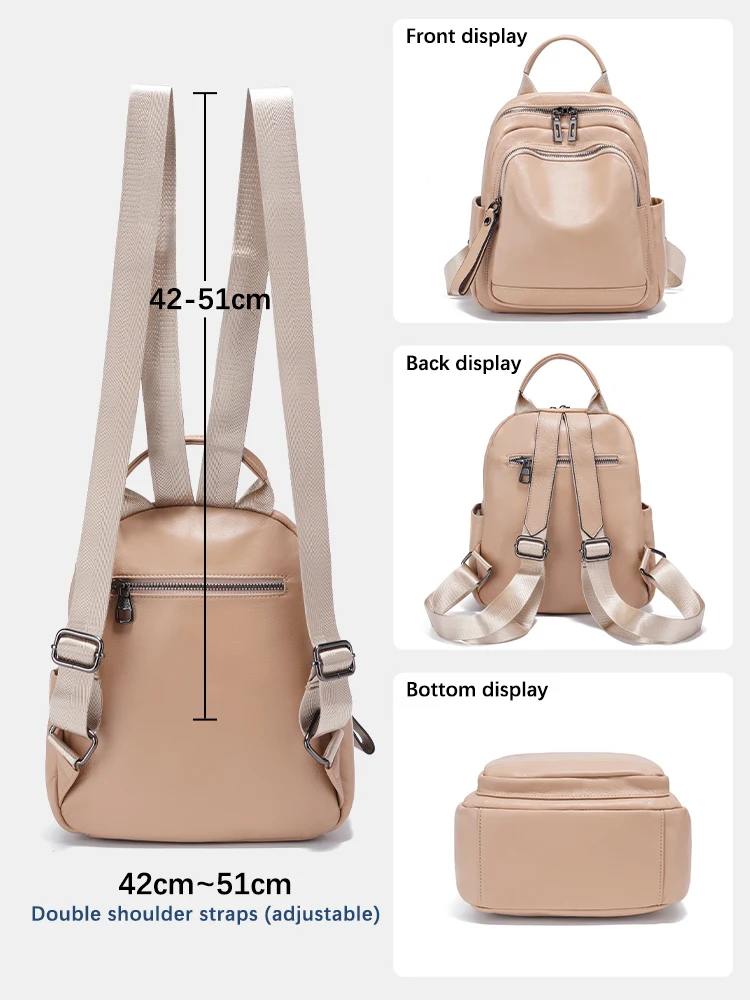
The Circular Economy: Repair, Reuse, and End-of-Life Considerations
True sustainability extends beyond production to include the entire lifecycle of leather goods. The circular economy approach aims to keep materials in use as long as possible, extract maximum value, and recover or regenerate products at the end of their useful life.
Product Longevity as Sustainability
Well-made leather products can serve for decades:
* Quality leather improves with age, developing character and patina
* Proper maintenance preserves functionality for generations
* Classic designs remain useful despite changing trends
* The environmental impact of production is distributed across many years of use
14 Inch Leather Laptop Backpack, Brown Leather Backpack, Men's Leather Backpack, Vintage Leather Backpack
Price range: $177.28 through $199.12 Select options This product has multiple variants. The options may be chosen on the product pageCarry On Leather Backpack, Roll Top Leather Backpack
Price range: $77.76 through $96.48 Select options This product has multiple variants. The options may be chosen on the product pageDesigner Mini Backpack, Mini Leather Backpack, Small Leather Sling Backpack, Women's Leather Backpack
Price range: $95.76 through $98.80 Select options This product has multiple variants. The options may be chosen on the product pageDesigner Mini Backpack, Designer Women's Backpack, Mini Leather Backpack, Women's Leather Backpack
Price range: $135.92 through $137.64 Select options This product has multiple variants. The options may be chosen on the product pageBlack Leather Backpack, Small Leather Backpack, Women's Leather Backpack
Price range: $112.96 through $116.12 Select options This product has multiple variants. The options may be chosen on the product page- Price range: $80.72 through $108.04 Select options This product has multiple variants. The options may be chosen on the product page
Repairability
Unlike many modern consumer goods, quality leather items can be restored repeatedly:
* Stitching can be replaced if worn or broken
* Hardware can be repaired or upgraded
* Worn areas can often be rehabilitated
* Proper ultimate guide to waterproofing leather bags helps prevent damage that would shorten usable life
End-of-Life Considerations
Different leather types have varying end-of-life outcomes:
* Vegetable-tanned leather biodegrades in 25-50 years under proper conditions
* Chrome-tanned leather biodegrades more slowly but will eventually break down
* Leather items can be dismantled and components recycled separately
* Leather can be shredded and reformed into composite materials
Upcycling and Second-Life Applications
Leather’s durability makes it ideal for creative reuse:
* Damaged leather goods can be transformed into smaller items
* Leather scraps become components in new products
* Worn leather develops character valued in vintage markets
* Crafters and artisans often repurpose leather from obsolete items
Biodegradability Comparison
Material end-of-life impacts vary significantly:
* Natural leather eventually returns to nature when properly disposed of
* Vegetable-tanned leather biodegrades more readily than chrome-tanned
* Most synthetic materials persist for hundreds of years
* Biodegradable alternatives vary widely in decomposition timeframes
By considering the entire lifecycle from production through disposal, consumers can make choices that minimize overall environmental impact rather than focusing solely on production methods.
Does Sustainable Leather Cost More? Value Considerations
Consumers often assume that sustainable options automatically carry premium prices. While environmentally responsible leather goods may have higher initial costs, understanding value requires looking beyond the price tag to consider long-term economics and broader impacts.
Initial Price Factors
Several elements contribute to the higher initial cost of sustainable leather goods:
* More expensive tanning processes (vegetable tanning takes longer than chrome tanning)
* Additional certification and verification expenses
* Higher-quality construction for extended durability
* Fair labor practices throughout the supply chain
* Smaller production volumes without economies of scale
The Cost-Per-Wear Concept
Value assessment should include longevity considerations:
* A $300 backpack used weekly for 10 years costs about 58 cents per use
* A $100 synthetic alternative replaced every 2 years for 10 years costs about 96 cents per use
* Quality leather goods often remain functional and attractive for decades
* Proper leather backpack care and maintenance significantly extends useful life, improving economic value
Quality Indicators Worth Paying For
Certain features justify higher prices through extended longevity:
* Full-grain leather that develops character rather than deteriorating
* Reinforced stress points that prevent premature failure
* Quality hardware that won’t corrode or break
* Thoughtful design that accommodates repair
* Construction techniques that allow component replacement
External Costs
Traditional pricing doesn’t reflect full environmental and social impacts:
* Lower-priced items may externalize costs through pollution
* Sustainable production internalizes these costs in the purchase price
* Workers receive fair compensation in responsible supply chains
* Reduced environmental cleanup and remediation costs
* Lower waste management burden on communities and ecosystems
When considering these factors, sustainably produced leather goods often represent better overall value despite higher initial purchase prices, particularly for items used regularly over many years.
Why Choosing Sustainable Leather Matters: The Broader Impact
Individual purchasing decisions may seem small in isolation, but collectively they shape industry practices and environmental outcomes. Understanding the broader impact of sustainable leather choices helps consumers recognize the significance of their decisions.
Environmental Benefits
Choosing sustainable leather reduces several environmental pressures:
* Lower chemical pollution in vulnerable watersheds
* Reduced water consumption in water-stressed regions
* Decreased energy use and associated carbon emissions
* Minimized waste generation throughout the production chain
* Extended product lifecycles that reduce resource demand
Influencing Industry Practices
Consumer preferences drive significant industry changes:
* Growing demand for sustainable options encourages all producers to improve
* Market competition based on environmental performance accelerates innovation
* Transparency becomes expected rather than exceptional
* Best practices spread through supply chains as they become standard expectations
* Investment increases in new technologies and approaches
Preserving Traditional Craftsmanship
Sustainable leather often preserves valuable cultural heritage:
* Support for skilled artisanal techniques that might otherwise disappear
* Continuation of traditional knowledge about natural materials
* Appreciation for quality and durability over disposable consumption
* Connection between consumers and makers through transparent production
Supporting Worker Wellbeing
Sustainable leather production typically improves working conditions:
* Reduced exposure to hazardous chemicals
* Safer production environments
* More stable employment through quality-focused production
* Preservation of skilled jobs with fair compensation
* Community benefits through responsible local production
By choosing sustainably produced leather goods, consumers not only acquire products with superior performance characteristics but also contribute to positive environmental and social outcomes that extend far beyond their individual purchases.
Is Leather Ever Truly Sustainable? A Balanced Perspective
Can animal products ever be environmentally friendly?
While no material is without environmental impact, responsibly produced leather offers several sustainability advantages. As a by-product of the food industry, quality leather utilizes material that might otherwise become waste. When properly sourced, processed with minimal chemicals, and crafted for longevity, leather can represent a responsible use of existing resources. The key lies in how the entire supply chain is managed—from animal husbandry to final product care.
Doesn’t leather production always use too many resources?
Traditional leather production is resource-intensive, but significant improvements continue to reduce its environmental footprint. Modern sustainable tanneries have cut water usage by up to 60% through recycling systems, dramatically reduced chemical use through better processes, and implemented energy efficiency measures. These advancements, combined with leather’s exceptional durability, create products whose environmental costs are distributed over many years of use rather than concentrated in frequent replacements.
Aren’t synthetic alternatives always better for the environment?
Contrary to common assumptions, standard synthetic “vegan leathers” derived from fossil fuels often have significant environmental downsides, including non-biodegradability, microplastic pollution, and relatively short useful lives. Emerging plant-based alternatives show promise but currently have their own limitations in durability and still often contain synthetic components. The environmental equation depends on numerous factors including production methods, product lifespan, and end-of-life considerations.
What about animal welfare concerns?
Ethical concerns about animal products are valid and personal. Sustainable leather approaches emphasize responsible animal husbandry and use of by-products rather than purpose-raised animals. For those prioritizing animal welfare but still wanting leather’s performance characteristics, second-hand leather goods offer a compromise position that extends the use of existing materials without creating new demand.
Where is the leather industry still falling short?
Despite improvements, challenges remain. Traceability systems need strengthening to verify claims throughout complex supply chains. Chemical use, while reduced, still poses environmental risks if improperly managed. Waste utilization has improved but continues to present challenges. The industry must also address worker conditions in regions with limited regulatory oversight. These areas require continued attention and improvement.
The sustainability of leather ultimately depends on specific sourcing, production methods, and consumer care practices. Neither blanket endorsement nor rejection adequately addresses the nuanced reality of this complex material. The most responsible approach involves informed choices based on transparent information about specific products and their full lifecycle impacts.

